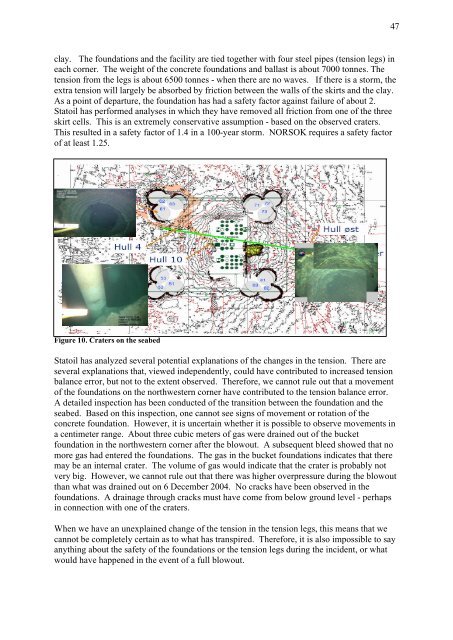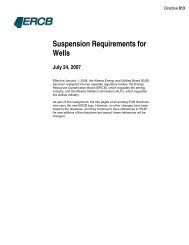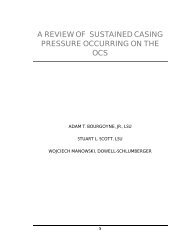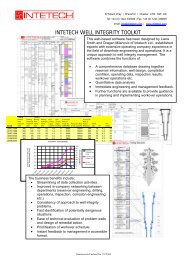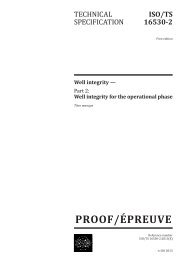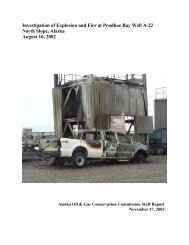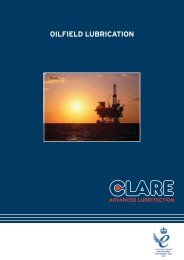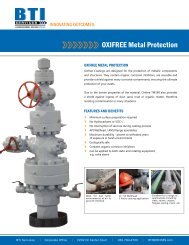Report Investigation of gas blowout on Snorre A - Well Integrity ...
Report Investigation of gas blowout on Snorre A - Well Integrity ...
Report Investigation of gas blowout on Snorre A - Well Integrity ...
Create successful ePaper yourself
Turn your PDF publications into a flip-book with our unique Google optimized e-Paper software.
clay. The foundati<strong>on</strong>s and the facility are tied together with four steel pipes (tensi<strong>on</strong> legs) in<br />
each corner. The weight <str<strong>on</strong>g>of</str<strong>on</strong>g> the c<strong>on</strong>crete foundati<strong>on</strong>s and ballast is about 7000 t<strong>on</strong>nes. The<br />
tensi<strong>on</strong> from the legs is about 6500 t<strong>on</strong>nes - when there are no waves. If there is a storm, the<br />
extra tensi<strong>on</strong> will largely be absorbed by fricti<strong>on</strong> between the walls <str<strong>on</strong>g>of</str<strong>on</strong>g> the skirts and the clay.<br />
As a point <str<strong>on</strong>g>of</str<strong>on</strong>g> departure, the foundati<strong>on</strong> has had a safety factor against failure <str<strong>on</strong>g>of</str<strong>on</strong>g> about 2.<br />
Statoil has performed analyses in which they have removed all fricti<strong>on</strong> from <strong>on</strong>e <str<strong>on</strong>g>of</str<strong>on</strong>g> the three<br />
skirt cells. This is an extremely c<strong>on</strong>servative assumpti<strong>on</strong> - based <strong>on</strong> the observed craters.<br />
This resulted in a safety factor <str<strong>on</strong>g>of</str<strong>on</strong>g> 1.4 in a 100-year storm. NORSOK requires a safety factor<br />
<str<strong>on</strong>g>of</str<strong>on</strong>g> at least 1.25.<br />
Figure 10. Craters <strong>on</strong> the seabed<br />
Statoil has analyzed several potential explanati<strong>on</strong>s <str<strong>on</strong>g>of</str<strong>on</strong>g> the changes in the tensi<strong>on</strong>. There are<br />
several explanati<strong>on</strong>s that, viewed independently, could have c<strong>on</strong>tributed to increased tensi<strong>on</strong><br />
balance error, but not to the extent observed. Therefore, we cannot rule out that a movement<br />
<str<strong>on</strong>g>of</str<strong>on</strong>g> the foundati<strong>on</strong>s <strong>on</strong> the northwestern corner have c<strong>on</strong>tributed to the tensi<strong>on</strong> balance error.<br />
A detailed inspecti<strong>on</strong> has been c<strong>on</strong>ducted <str<strong>on</strong>g>of</str<strong>on</strong>g> the transiti<strong>on</strong> between the foundati<strong>on</strong> and the<br />
seabed. Based <strong>on</strong> this inspecti<strong>on</strong>, <strong>on</strong>e cannot see signs <str<strong>on</strong>g>of</str<strong>on</strong>g> movement or rotati<strong>on</strong> <str<strong>on</strong>g>of</str<strong>on</strong>g> the<br />
c<strong>on</strong>crete foundati<strong>on</strong>. However, it is uncertain whether it is possible to observe movements in<br />
a centimeter range. About three cubic meters <str<strong>on</strong>g>of</str<strong>on</strong>g> <str<strong>on</strong>g>gas</str<strong>on</strong>g> were drained out <str<strong>on</strong>g>of</str<strong>on</strong>g> the bucket<br />
foundati<strong>on</strong> in the northwestern corner after the <str<strong>on</strong>g>blowout</str<strong>on</strong>g>. A subsequent bleed showed that no<br />
more <str<strong>on</strong>g>gas</str<strong>on</strong>g> had entered the foundati<strong>on</strong>s. The <str<strong>on</strong>g>gas</str<strong>on</strong>g> in the bucket foundati<strong>on</strong>s indicates that there<br />
may be an internal crater. The volume <str<strong>on</strong>g>of</str<strong>on</strong>g> <str<strong>on</strong>g>gas</str<strong>on</strong>g> would indicate that the crater is probably not<br />
very big. However, we cannot rule out that there was higher overpressure during the <str<strong>on</strong>g>blowout</str<strong>on</strong>g><br />
than what was drained out <strong>on</strong> 6 December 2004. No cracks have been observed in the<br />
foundati<strong>on</strong>s. A drainage through cracks must have come from below ground level - perhaps<br />
in c<strong>on</strong>necti<strong>on</strong> with <strong>on</strong>e <str<strong>on</strong>g>of</str<strong>on</strong>g> the craters.<br />
When we have an unexplained change <str<strong>on</strong>g>of</str<strong>on</strong>g> the tensi<strong>on</strong> in the tensi<strong>on</strong> legs, this means that we<br />
cannot be completely certain as to what has transpired. Therefore, it is also impossible to say<br />
anything about the safety <str<strong>on</strong>g>of</str<strong>on</strong>g> the foundati<strong>on</strong>s or the tensi<strong>on</strong> legs during the incident, or what<br />
would have happened in the event <str<strong>on</strong>g>of</str<strong>on</strong>g> a full <str<strong>on</strong>g>blowout</str<strong>on</strong>g>.<br />
47


